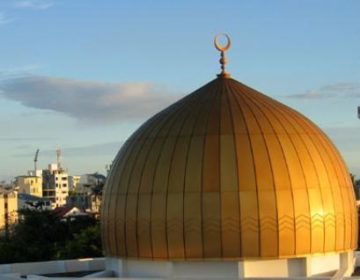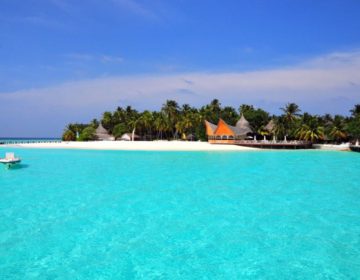Addu Atoll lies just south of the equator and is the southernmost atoll in the Maldives archipelago. Gan Island is the most southern island at latitude 0˚ 42’S. There are four inhabited islands and around 20 small uninhabited islands and sandbars. The atoll is heart-shaped and about 18 kilometers wide and 15 kilometers long. Most of the atoll is surrounded by islands. The islands on the western side, Gan, Feydhoo, Maradhoo, and Hithadhoo are connected by a causeway creating a formidable barrier to the rising and falling tides. At the causeway, water levels vary as much as half a meter on either side during the change of tide. Each island is densely covered in coconut trees, and the villages are clean and tidy. The island communities are small enough for incoming mail to be addressed to the houses only. The houses are mostly built of coral and have lush gardens with banana trees bursting with fruit.

Hithadhoo
Hithadhoo is the capital of the atoll with some historical features. At Koattey are the ruins of an old fort. Archaeologist, Mr. H.C.P. Bell visited the island in 1922 to investigate the ruins, but the origins of this fort are not known for sure. One legend says it was the stronghold of the rebel Maldivians led by Bodu Thakurufaanu who eventually ousted the Portuguese from the Maldives in 1557. According to historians, it is more likely that the fort was built by the ‘Lord of the Maldives’ Kunhali Marakkar, of Malabar, who was trading in the south of the Maldives during the Portuguese period. Kunhali had more than 200 big ships trading and looting in the Indian Ocean and the fort, with its good anchorage at Koattey, would have been a secure base for his ships that were being pursued and destroyed by the Portuguese.
On the northwestern point of the island at Fen Muli are the concrete remains of a British battery built early in World War II to defend the northwest side of Addu. About four kilometers south of Fen Muli o the western side of Hithadhoo are the remains of another old fort that has been mostly washed away. The origins of this fort are unknown.
On Hithadhoo in the Thakurufaanu Miskiiy is the grave of Sultan Hassan X (1701 AD) who died in 1765 after 60 years in exile.
 Hithadhoo Island
Hithadhoo Island
Maradhoo
There are two villages on the island of Maradhoo, namely Maradhoo and Maradhoo- Feydhoo. To make way for the air force base on Gan, the population of Gan was moved to neighboring Feydhoo and the Feydhoo islanders were integrated into the island of Maradhoo. The southern end of Maradhoo Island is now called Maradhoo-Feydhoo. A causeway connecting Maradhoo to Hankede Island was first built in 1970, and a new highway connecting the islands was completed in 2004.
 Manta Ray Feeding Station at Maradhoo Island
Manta Ray Feeding Station at Maradhoo Island
Feydhoo
Feydhoo was connected to Maradhoo by a causeway in 1970.
Gan
Gan was cleared of vegetation during World War II to make way for the British air force base. It is now an international airport and the officers’ quarters is the site of Equator Village-Gan, a resort that opened in 1995. It was previously known as the Ocean Reef Club. This resort is entirely different from any other in the Maldives. It is the only one where tourists can mix freely with the local people. A causeway connecting Gan and Feydhoo was opened in 1981 which allows guests to take long bicycles rides through the villages on the western side of the atoll. There is a security checkpoint at the causeway.
The air force base was solidly constructed, and the buildings, roads, workshops, gardens, and airport have been well maintained. The roads are lined with tall trees, and there is a small post office and a few old shops. The old church had been converted to a mosque. A gun battery was located on the eastern side of Gan Island. The guns of this battery were relocated to the war memorial near the Equator Village-Gan.
Most tourists staying at Equator Village-Gan arrive via Island Aviation Services, which flies daily between Malé and Gan Island. The flight path is directly over the atolls and is a great way to get an aerial perspective of the islands. For a closer view of the islands, adventurous travelers and divers can make safari trips between Malé and Gan Island. The new international airport at Gan will bring tourists into the southern regions directly from overseas.
Residents of adjoining islands are allowed on Gan Island during the daytime, but require work permits to enter at night.
 Equator Village-Gan
Equator Village-Gan
Hulhumeedhoo
There are two villages on this island, Hulhudhoo, and Meedhoo. The concrete remains of a World War II battery are on the northeastern point of the island.
Kandu Huraa
Kandu Huraa lies in the middle-north of the atoll and is known a Bushy Island. During World War II all the control switches for the minefields around the atoll were located here.
 Kandu Huraa
Kandu Huraa
BRITISH INVOLVEMENT
In 1887, the Maldives was recognized as a protectorate of Great Britain and the control of the country’s defense and foreign relations were vested in Great Britain. The entire period of British involvement stretched formally up to 1965 when the Maldives gained political independence.
With the outbreak of World War II, the Maldives became an essential link in the allied defenses against the Japanese in the Indian Ocean. When the British moved into Addu Atoll in 1941, there were 5,600 local inhabitants, most of who suddenly found themselves employed (in 1995 the population was 21,000). Gan Island became secretly known as ‘Port T’ with the administration of the base initially carried out aboard a navy ship. All the forces – army, navy, and air force – were positioned in this strategic Indian Ocean base. Six months later, regiments from Bengal and India arrived, and a base for sea-planes was built at Hithadhoo lagoon, where planes flew in from as far away as Singapore and Trincomalee in Sri Lanka. Underground bunkers for supplies and bombs were constructed at Maradhoo, then covered with trees for camouflage. The first airfield was located on Gan with the runway constructed of steel sheeting.
Almost all the vegetation was stripped, and villages flattened to make way for the runway that ran the length of the island. The inhabitants were moved to neighboring Feydhoo and jetties and buildings constructed. The atoll’s defenses were strengthened and submarine nets and mines laid across the entrances of the atoll. Also destroyed by the runway were the last remnants of Buddhism on the island.
“On March 9, 1944, a German submarine U-183 torpedoed the British oil tankers, British Loyalty that was anchored near Vilingili in Addu harbor. A man named Mohammed from Hithadhoo recalls:
“About a week before the attack the base was on full alert because of an uninhabited high-flying aircraft. Some planes took off to investigate, but the enemy plane was not found. Then, one week later, a submarine just outside the atoll fired diagonally through Gan Channel, through the anti-submarine nets, and into a tanker anchored inside the atoll at Vilingili. The attack was in the night, and the explosion brought everyone to full alert. In the morning, there was a big oil slick which the British cleaned up. After this attack, the British moved their refueling base to Diego Garcia (in the Chagos Islands).”
After it was repaired, the British Loyalty was used as a storage hulk and finally scuttled on January 15, 1946, inside the atoll to the southeast of Hithadhoo. When destroyed she had 6417 tons of fuel oil, 43,250 gallons of octane and 105 tons of MT spirit on board. It is a spectacular wreck dive.
After World War II, the British pulled out of Gan, but with the independence of India and Sri Lanka after the war, Britain was apprehensive about losing it military strength in the region. In 1952, the British Air Ministry carried out a feasibility survey of Gan Island for the construction of a modern airfield and when the Government of Sri Lanka declared in 1956 that it was not prepared to allow a British military presence on its Trincomalee harbour and Katunayake airport, the Maldives was already online as an alternative arrangement to link Britain with Australia and the Far East.
 Short Belfast RAF on Gan Island in 1969
Short Belfast RAF on Gan Island in 1969
An agreement for the use of Gan Island as an airfield and Hithadhoo as a radio-communications center was concluded, and work on the new base began in the second half of 1957, replacing defense facilities in Sri Lanka. When the Maldives gained independence in 1965, Britain retained its lease on Gan. It was initially to last up to 1986, but it was terminated early in 1976, and the British withdrew their forces from the Maldives.
The Gan airbase covered one of the largest aerial search areas in the world and could handle the most sophisticated of RAF aircraft with the latest navigational and landing aids. It dealt with some 630 aircraft and 12,500 passengers in 1960 to 1961.
Soon after the British withdrawal, Gan Island was reported to be available for lease, but the Government, under President Nasir, made it clear that it did not wish to lease the base to any superpower, or others for military purposes. An offer of one million dollars for the lease by the Soviet Union in 1979 for “use by its fishing fleets,” was turned down. A garment industry was later established at Gan and tourism is now making inroads into Addu Atoll .
 Gan Island Causeway
Gan Island Causeway
(Source: Dive Maldives: A guide to the Maldives Archipelago. Tim Godfrey. Atoll Editions)



